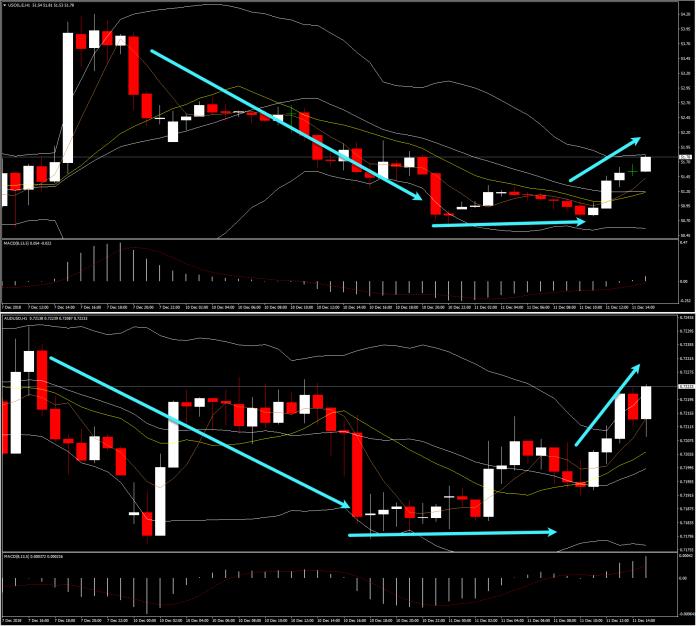Fundamental strategies focus on removing any sentiment and noise from the markets and emphasise on boil down to the, at time harsh, underlying economic relationships which dominate the markets. While the official name is correlations, it is simply nothing but the understanding that one variable has a positive or negative relationship with another.
As we suggested above, fundamental strategies do not aim at explaining short-term fluctuations in the markets but aim at capturing longer-term trends. Longer-term does not refer to some abstract date in the future; in contrast, it refers to identifying a clear-cut trend in specific time-frames, ranging from hourly to weekly charts.
Take for example the relationship between the Aussie Dollar and the price of Oil. What you need to know is that there exists a fundamental relationship between the two. A short search reveals that Australia exports large quantities of crude oil, at times reaching up to 75% of its production. Higher exports mean that more demand for domestic goods exists, which boosts up the currency. If demand for Australia’s oil declined, then we would expect that this would have a negative effect on total exports and would reduce its trade surplus. Nonetheless, developments in Oil prices will not impact the demand for Oil, however, they will have a strong impact on the amount of income earned. In economics terms, we would be observing a price effect, and not a quantity effect: a drop in the price of Oil would reduce income from exports, despite no demand effect. Consequently, we would expect that the AUD would have a positive relationship with the price of Oil.
Note that in order to observe this behaviour we would need to use an Aussie pair which is not affected by the price of oil. For example, one could use the AUDUSD pair to gauge the impact. The first graph in this post suggests that such a relationship holds: as USOIL declined, AUDUSD followed suit, while the pairs moved similarly even at the stabilization and subsequent rise. This is the point where we underline that the movements are not expected to be exact but should have some broad resemblance. As we previously said, the longer-run strategies do not aim at capturing all movements but just the overall trend.
The Aussie is not the only currency with strong ties to the price of Oil. The Loonie also has a similar relationship, especially considering that Canada mainly exports to the US. On the opposite side, the Yen is expected to depreciate as the price of Oil increases, given that the country is a major Oil importer.
As expected, trading strategies could potentially take advantage of this behaviour: for example, a trader could potentially short Oil and go long on the Aussie Dollar and do what is known as a hedging strategy, i.e. take two opposite bets and potentially zero out his profit or loss. Naturally, given that this is the real world, hedging does not usually end up in zero risk but assists in risking a smaller percentage of his portfolio if a sharp market movement occurs. Thus, in order for the trade to be profitable, the trader would need to understand which of the two waves he intends to ride, given that at some point he would have to close one of the two positions.
Click here to access the HotForex Economic Calendar
Dr Nektarios Michail
Market Analyst
HotForex
Disclaimer: This material is provided as a general marketing communication for information purposes only and does not constitute an independent investment research. Nothing in this communication contains, or should be considered as containing, an investment advice or an investment recommendation or a solicitation for the purpose of buying or selling of any financial instrument. All information provided is gathered from reputable sources and any information containing an indication of past performance is not a guarantee or reliable indicator of future performance. Users acknowledge that any investment in FX and CFDs products is characterized by a certain degree of uncertainty and that any investment of this nature involves a high level of risk for which the users are solely responsible and liable. We assume no liability for any loss arising from any investment made based on the information provided in this communication. This communication must not be reproduced or further distributed without our prior written permission.



















